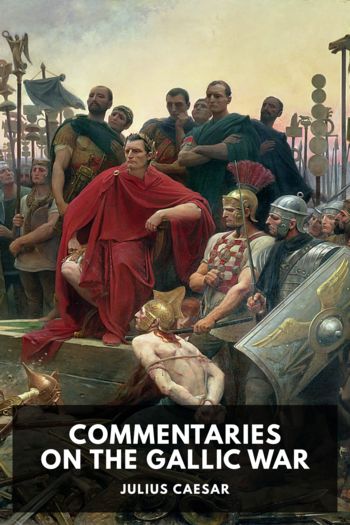The Story of the Amulet - E. Nesbit (smart books to read TXT) 📗

- Author: E. Nesbit
Book online «The Story of the Amulet - E. Nesbit (smart books to read TXT) 📗». Author E. Nesbit
Cyril’s speech didn’t keep the crowd from pressing round and looking as eagerly as ever at the clothing of the children. Anthea had an idea that these people had never seen woven stuff before, and she saw how wonderful and strange it must seem to people who had never had any clothes but the skins of beasts. The sewing, too, of modern clothes seemed to astonish them very much. They must have been able to sew themselves, by the way, for men who seemed to be the chiefs wore knickerbockers of goatskin or deerskin, fastened round the waist with twisted strips of hide. And the women wore long skimpy skirts of animals’ skins. The people were not very tall, their hair was fair, and men and women both had it short. Their eyes were blue, and that seemed odd in Egypt. Most of them were tattooed like sailors, only more roughly.
“What is this? What is this?” they kept asking touching the children’s clothes curiously.
Anthea hastily took off Jane’s frilly lace collar and handed it to the woman who seemed most friendly.
“Take this,” she said, “and look at it. And leave us alone. We want to talk among ourselves.”
She spoke in the tone of authority which she had always found successful when she had not time to coax her baby brother to do as he was told. The tone was just as successful now. The children were left together and the crowd retreated. It paused a dozen yards away to look at the lace collar and to go on talking as hard as it could.
The children will never know what those people said, though they knew well enough that they, the four strangers, were the subject of the talk. They tried to comfort themselves by remembering the girl’s promise of friendliness, but of course the thought of the charm was more comfortable than anything else. They sat down on the sand in the shadow of the hedged-round place in the middle of the village, and now for the first time they were able to look about them and to see something more than a crowd of eager, curious faces.
They here noticed that the women wore necklaces made of beads of different coloured stone, and from these hung pendants of odd, strange shapes, and some of them had bracelets of ivory and flint.
“I say,” said Robert, “what a lot we could teach them if we stayed here!”
“I expect they could teach us something too,” said Cyril. “Did you notice that flint bracelet the woman had that Anthea gave the collar to? That must have taken some making. Look here, they’ll get suspicious if we talk among ourselves, and I do want to know about how they do things. Let’s get the girl to show us round, and we can be thinking about how to get the Amulet at the same time. Only mind, we must keep together.”
Anthea beckoned to the girl, who was standing a little way off looking wistfully at them, and she came gladly.
“Tell us how you make the bracelets, the stone ones,” said Cyril.
“With other stones,” said the girl; “the men make them; we have men of special skill in such work.”
“Haven’t you any iron tools?”
“Iron,” said the girl, “I don’t know what you mean.” It was the first word she had not understood.
“Are all your tools of flint?” asked Cyril.
“Of course,” said the girl, opening her eyes wide.
I wish I had time to tell you of that talk. The English children wanted to hear all about this new place, but they also wanted to tell of their own country. It was like when you come back from your holidays and you want to hear and to tell everything at the same time. As the talk went on there were more and more words that the girl could not understand, and the children soon gave up the attempt to explain to her what their own country was like, when they began to see how very few of the things they had always thought they could not do without were really not at all necessary to life.
The girl showed them how the huts were made—indeed, as one was being made that very day she took them to look at it. The way of building was very different from ours. The men stuck long pieces of wood into a piece of ground the size of the hut they wanted to make. These were about eight inches apart; then they put in another row about eight inches away from the first, and then a third row still further out. Then all the space between was filled up with small branches and twigs, and then daubed over with black mud worked with the feet till it was soft and sticky like putty.
The girl told them how the men went hunting with flint spears and arrows, and how they made boats with reeds and clay. Then she explained the reed thing in the river that she had taken the fish out of. It was a fish-trap—just a ring of reeds set up in the water with only one little opening in it, and in this opening, just below the water, were stuck reeds slanting the way of the river’s flow, so that the fish, when they had swum sillily in, sillily couldn’t get out again. She showed them the clay pots





Comments (0)